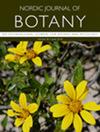Untangling the taxonomy and geographic distribution of Quararibea floribunda (Malvaceae: Malvoideae)
IF 1.1
4区 生物学
Q3 PLANT SCIENCES
引用次数: 0
Abstract
Quararibea floribunda, a species endemic to Brazil, is poorly studied taxonomically, and little is known about its ecology and conservation status. Since its publication in 1842, only a few studies have reported on its morphological circumscription, thus remaining as a complex in the taxonomy of Quararibea. In addition, little is known about its geographic distribution, which, according to most authors, is restricted to the Cerrado Biome, characterized mainly by its dry forests. Therefore, we herein review and clarify the morphological circumscription and distribution of Q. floribunda in different vegetation types, designate a lectotype, and recognize its conservation status as vulnerable (VU). The present study is based on analysis of protologues and further pertinent literature. Several herbaria were consulted, both in person and online. Fieldwork was done between 2017 and 2020 in different locations of midwestern and southeastern Brazil, mainly in dry forests of the Cerrado Biome. We confirm that Q. floribunda also occurs in the Atlantic Forest Biome and that it is not exclusive to the Cerrado Biome, as previously thought. All known populations in this biome inhabit humid habitats, and as such, they are closer to the vegetation of the Atlantic Forest Biome than the typical Cerrado dry forests. In addition to assessing the conservation status of Q. floribunda, we evaluate its nomenclatural history, leading to the designation of a lectotype, finally highlighting vegetative and floral diagnostic characters. A distribution map is provided, as well as a morphological comparative analysis between species with foliar domatia in extra-Amazonian Brazil.解开Quararibea floribunda(锦葵科:锦葵属)的分类和地理分布问题
巴西特有种Quararibea floribunda在分类学上的研究很少,对其生态学和保护状况也知之甚少。自 1842 年发表以来,仅有少数研究报告了其形态特征,因此在 Quararibea 分类学中仍是一个复杂的问题。此外,人们对它的地理分布也知之甚少,大多数作者认为它仅限于以干燥森林为主要特征的塞拉多生物群落。因此,我们在本文中回顾并阐明了花叶蓟马(Q. floribunda)的形态特征以及在不同植被类型中的分布情况,指定了一个主模式,并确认其保护地位为易危(VU)。本研究基于对原型的分析和进一步的相关文献。研究人员亲自或在线咨询了多家标本馆。实地考察于 2017 年至 2020 年期间在巴西中西部和东南部的不同地点进行,主要是在塞拉多生物群落的干燥森林中。我们证实,Q. floribunda 也分布在大西洋森林生物群落中,并不像之前认为的那样是塞拉多生物群落的独有物种。该生物群落中的所有已知种群都栖息在潮湿的生境中,因此,与典型的塞拉多干旱森林相比,它们更接近大西洋森林生物群落的植被。除了评估 Q. floribunda 的保护状况外,我们还评估了它的命名历史,最终指定了一个标准模式,并强调了植被和花卉的诊断特征。我们还提供了一份分布图,并对巴西亚马逊河流域以外地区具有叶状穹隆的物种进行了形态学比较分析。
本文章由计算机程序翻译,如有差异,请以英文原文为准。
求助全文
约1分钟内获得全文
求助全文
来源期刊

Nordic Journal of Botany
生物-植物科学
CiteScore
1.90
自引率
11.10%
发文量
100
审稿时长
2 months
期刊介绍:
Nordic Journal of Botany publishes original contributions on all aspects of the taxonomy, evolution, conservation, ecology and biogeography of plants (including algae and bryophytes) and fungi.
 求助内容:
求助内容: 应助结果提醒方式:
应助结果提醒方式:


